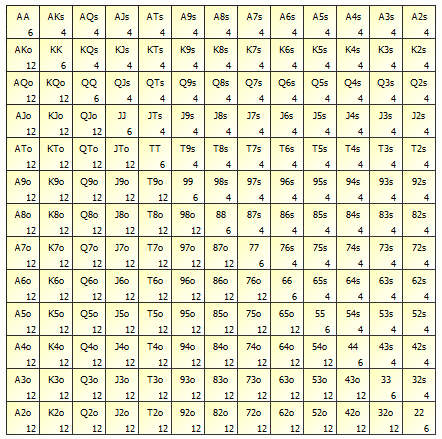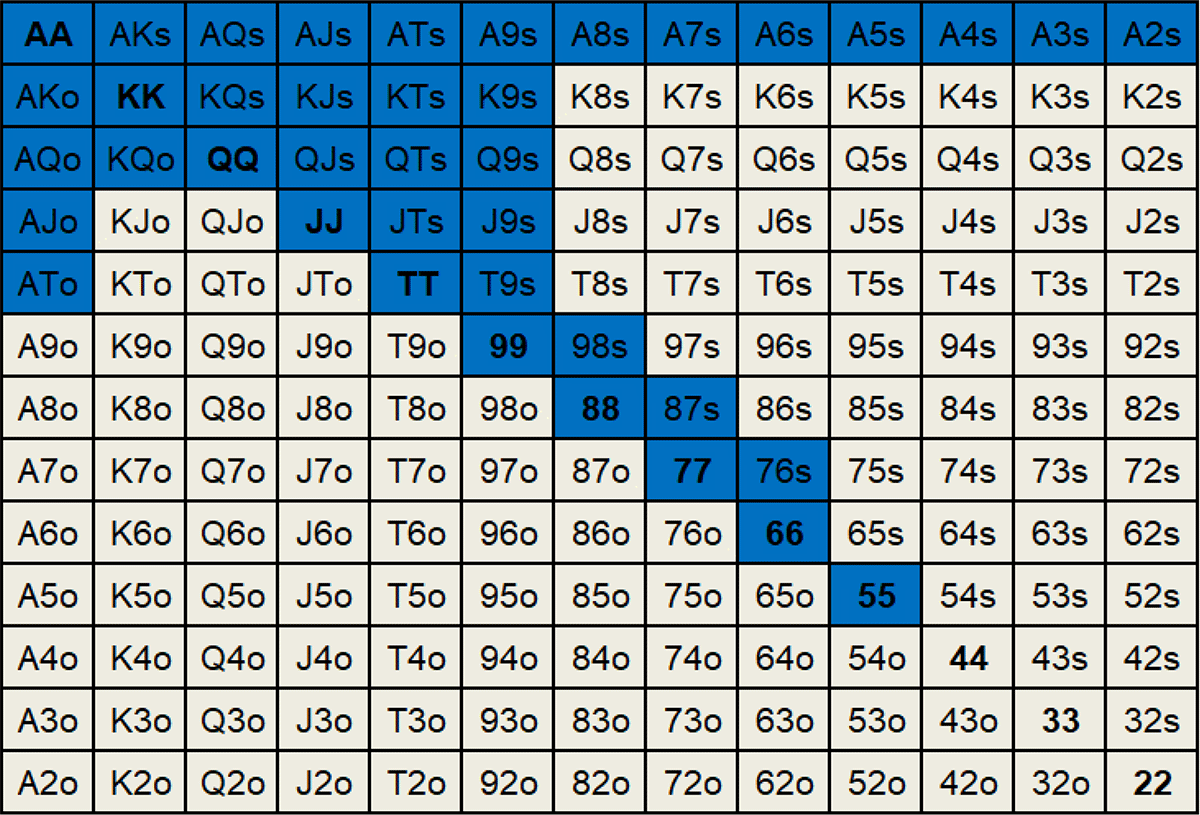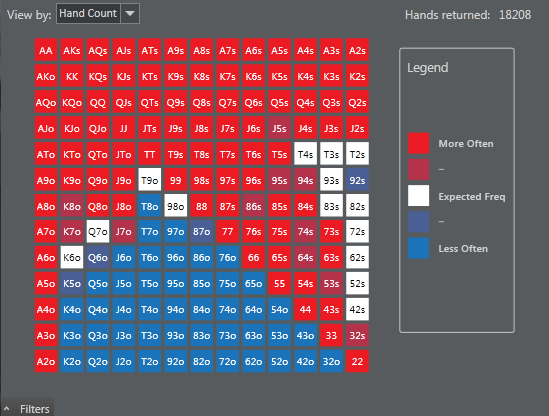Poker Strategy Open Raising Chart
PLO Starting Hands Chart. Here is a basic and conservative pot limit omaha hand chart for being the first to open (everyone folds to you) in various positions. Note that “BBB” or “NNN” assumes the random cards are different (unpaired). Key: B: Broadway card (A, K, Q, J, T) ss: Single suited. Push Fold Chart: Nash Poker Chart (Poker Shove Chart) Charts provided below are push/fold charts for heads-up play. Therefore, for games with more than 2 players, push charts are applicable for SB open shove ranges and call charts are applicable for BB calling vs.
Open-Raising in Cash Games vs Tournaments. Let’s start with the basic differences between open-raising in cash games and MTTs. In MTTs, open-raising small and often is usually best because of the shorter stacks and extra dead money in the pot. In cash games, the deep stacks call for bigger open-raise sizes.
NL Hold’em Starting Hand Charts
One aspect of the game of No-Limit Hold’em that causes beginning players much grief is deciding which hands to play and which hands to dump. NL Hold’em is much more difficult than Limit Hold’em because the value of a hand depends on so many factors other than just the cards in your hand. Despite this difficulty, our coaches believe that following some general guidelines and adjusting from these is a better solution than having no guidelines at all. Given that well over half of your profitability in NL Hold’em is based on hand selection alone, we have developed these charts to help you better determine whether to play or fold.
There are no perfect No-Limit starting hand charts. That is because there are many factors that affect your decision, and charts cannot account for all of them. Some of these include:
- The size of your opponent's stacks.
- How loose or tight, passive or aggressive, your opponents are.
- Where these opponents are located at the table – for example, does an aggressive player still have to act after you?
- Your image at the table – for example, how tight or tricky you are perceived.
That being said, these charts will serve you well in most typical low-stakes No-Limit cash games, such as games with blinds of $1/$2, and home games. These games typically have several loose players at the table, and good opportunities for winning big pots with suited connectors and pocket pairs. With practice, you will be able to be a consistently winning player with these charts as a starting point. As you improve, you'll find yourself making adjustments to these charts based on the factors listed above, and more.

AGAIN: These charts are a good starting point for beginners. Specifically, Chart #1 recommends a significant amount of limping. This is great in loose, passive games but less often seen in tougher games. You’ll find other training material on Advanced Poker Training that may recommend a more aggressive approach for more experienced players.
Note: It would be a serious mistake to apply these hand charts before reading the Frequent Asked Questions first.

Poker Strategy Open Raising Chart Sheet
CHART #1 ‐ LOOSE, PASSIVE GAME (OFTEN 4-5 LIMPERS PER HAND)
NO ONE HAS RAISED YET
- Raise Always
- Call from Early Position, otherwise raise
- Call always
- Call from Middle or Late Position if the conditions are right (see Frequently Asked Questions)
CHART #2 ‐ TIGHTER GAME (FEWER LIMPERS) OR MORE AGGRESSIVE GAME
NO ONE HAS RAISED YET
- Raise Always
- Call from Early Position, otherwise raise
- Call (or Raise) from Middle or Late Position if the conditions are right (see Frequently Asked Questions)
CHART #3 ‐ THERE HAS BEEN A SINGLE RAISE
(3‐5 TIMES THE BIG BLIND) BEFORE YOU
- Re‐Raise Always
- Call from Early Position, otherwise re‐raise
- Call always
- Call from Middle or Late Position if the conditions are right (see Frequently Asked Questions)
FREQUENTLY ASKED QUESTIONS
For the hands in yellow, what do you mean when you say to play these hands if the conditions are right? The hands in yellow are speculative hands. They should always be folded from Early Position. From other positions, they can be profitable given the right conditions. Some of the questions to ask yourself:
- Are there other players who have called so far (the more, the better)?
- Are the players who have called playing poorly after the flop? Will they pay me off if I hit something?
- Is there an aggressive player still to act behind me (you might get raised and have to fold)?
- If there has been a raise and no other callers, what chance do I have of using my position after the flop to win the hand even if I don't improve (Chart #3 only)?
Why does Chart #2 say to sometimes raise with the hands in yellow, but Chart #1 does not? We have different goals in mind. Using Chart #1, we want to call to encourage additional players to enter the pot. These hands will be immensely profitable when our loose, passive opponents enter the hand, and get trapped when we flop a set, or make a well-disguised straight. When using Chart #2, however, we want to size up the opponents still to act. If they are tight, we can raise. Sometimes, we'll pick up the blinds. Other times, our pre-flop aggression will allow us to take down the pot on the flop.

What's the difference between AKs and AKo? AKs means an Ace and King of the same suit. AKo means an Ace and King of different suits.
What are early, middle, and late position? Early Position is generally the first 2 (in a nine player game) or 3 (in a ten player game) positions after the blinds. Late Position is the “cutoff” position (to the right of the dealer), and dealer button positions. Middle Position is everything in between.
How much should I raise? As a general rule, raise 3 to 4 times the big blind, plus 1 extra big blind for every player who has called before you. So if there are 2 callers already, raise between 5 and 6 times the big blind.
What if someone raises after I call? Whether you call the raise depends on how much money the raiser has for you to win, how many other players are involved, and what type of hand you have. As a general rule, if you have a pocket pair, lean towards calling. If there are a lot of other players (and therefore a big pot), lean towards calling. In general, fold suited connectors from early position. Fold hands like KQ that don't play well against a raiser.
How do I play from the blinds? From the small blind, play the same hands you would play from late position, plus a few more. But don't call with junk hands like T5o, just because it is “cheap”. From the big blind, if there is a raise to you, play like you would if you had already called from early position.
The chart says to fold KQo to a raise. Really? Yes, this hand performs very poorly against typical raising hands. Against AK, AQ, AA, KK, QQ, you are a big underdog. Other typical raising hands like JJ, TT, 99, AJs, are slightly ahead of you as well. The only time you might call or re-raise is from late position, if the opener was in middle or late position, indicating they might have a wider range of hands.
I was told to fold AJo from Early Position, why do you say to call with it? Folding AJo is not a bad idea in many games. We included it because, at low stakes tables (even tight or aggressive ones), the players are often playing badly enough after the flop that it can be profitable. We used data from millions of hands of low-limit poker to analyze this. The same could be said for KQo, ATs, and KJs – you can make a small profit in the long run at most low-stakes games, but folding would be perfectly acceptable from early position.

Can I use these charts in a NL Hold'em tournament? The charts would be best applicable to the early stages of a NL tournament, when everyone has a deep stack. In the middle and later stages, they should not be used.
Read all our instructional articles
Open raising is one of the most fundamental areas of the game
where many players seem to struggle. Whether it means that a
player can’t determine what types of hands to open raise with,
how much to raise, what to fold to, or anything else, it’s
definitely a major problem area. Since every game is so
different, it becomes very impossible to define set ranges of
hands to raise with and the proper correlated bet sizes. With
that said, however, we hope that this article will serve as a
useful guide towards understanding the basic concepts behind
open raises.
In reality, open raising is an initial process of trial and
error. Once you get past the stage of trial, you need to be able
to critically analyze what does and doesn’t work. Taking it one
step further, you’ll then be forced to determine why any play
worked or didn’t work. Poker is always about digging deeper
until you find the absolute most simplistic reasoning behind why
something will work. You should never open raise to open raise,
and in understanding this much alone, you’ll have already
conquered half of the battle.
Short Handed vs. Full Ring Games and Online vs. Live Games
One of the primary disparities between open raise ranges and
bet sizing is found in the format of the game that you are
playing in. Where AT might be a fold in a
full ring game, it’s most often worthy of a raise in a
short handed game. Being able to determine how ranges shift
depending upon how many people are playing is one of the most
important things that you can do. While it will ultimately only
change a handful of borderline hands from folds to raises, these
marginal differences can make all of the difference in the long
run.
In live play, a general open range in short handed games is
A9/AT+, any two face cards, and any pocket pair. Though this
range is quite specific, you’ll likely find that it’s also
quite useless, given that most live cash games don’t play short
handed, and when they do they are likely to break relatively
quickly. Of course, knowing which types of hands should call for
a raise is still going to be valuable, even if only on rare
occasions.
Again in live play, standard full ring games will call for a
bit different range of open raise worthy hands. QK is on the
borderline of open raises, QJ is almost always out of the
equation, and AT is very marginal. AJ+ is an open in most
situations, and 88+ is usually worth opening with. The reasoning
for only opening 88+ is the simple fact that
smaller pocket pairs will find most all of their value in
set mining. As a result, raising with 55, for example, is going
to be difficult if you are faced with a re-raise.
If you limp in, however, you can safely call an open raise from your
opponent and still be playing in the pot at a reasonable price.
For AJ, 88-99, a re-raise will frequently be enough to denote a
fold, depending upon the size of the raise and how many others
called. If you open with AJ, get re raised by one player, and
then are the only one left in the hand and are sitting out of
position, you should be folding. If you raise with 88, get re
raised, see two calls, and can play in position, it’s a clear
cut call. In full ring games, the expanded player base will
dramatically shift how and what hands are able to be played.
Online play is much more universal across the different types
of tables that are available. Any pocket pair, QJ/QK+ and AT+
are the standard hands for which an open raise should be made.
Of course there will be exceptions that are going to apply, but
No Limit Hold’em cash games should generally abide by this
specific base range of hands. Open limping is just not an option
in online poker as it is in live poker.
Poker Strategy Open Raising Charter
Position
Poker Strategy Open Raising Chart Template
Position will allow for you to expand the number of hands
that are going to be fit for open raising. K8 suited isn’t
going to make sense to open raise with from under the gun, but
it will be the perfect open raise if you are on the button and
are looking to steal. The less action that there is and the
closer to the button that you are, the more value that every
single hand will have. This doesn’t mean that you should be
firing out raises with reckless abandon, but that you should
seek out opportunities to be aggressive when possible and
logical. The more that you stray from typical open raising
hands, the less useful that any guidelines for raise worthy
hands will be.
Poker Strategy Open Raising Charts
Bet Sizing
Bet sizing is something that’s so incredibly simplistic, even
systematic, yet so terribly executed by so many players.
Have you ever noticed that some people will open with a 4x raise
one time, a 5x raise the next, and then a 10x raise? These
types of players telegraph their hands with the size of their
open raises and are easy to play against. If you want to win,
however, you should be making your open raises as deceptive as
possible.
In live games, a general range of 3-6x times the big blind
will be ideal for open raise bet sizing. In a $2/$5 game, a
$15-$30 open raise will work just fine. You should adjust the
exact sizing based on your opponents’ likelihood to call. At a
loose table, make bigger open raises, at a tight table, remain
moderate in your bets.
When you are open raising but are facing a pot with limpers,
you should again adjust your raise size. If you were open
raising to 5x at $2/$5 when under the gun (to $25), add 1 big
blind to that raise per limper. For example, with one limper the
raise would be to $30. With two limpers the open raise would be
to $35. All things considered, bet sizing is actually one of the
easiest to understand dynamics involved in open raising.